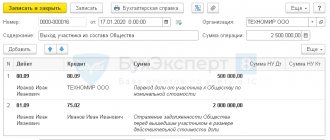Promotion: what is it?
A share is an element inherent in joint stock companies (JSC).
The authorized capital (AC) of these companies is divided into units of participation called shares. The size of the charter capital, the number and par value of shares are determined by the first (constituent) meeting of the owners of the joint-stock company. These values are reflected in the company's charter and in the registration documents of the initial issue (issue) of shares. Each of the participants of the joint-stock company, which can be both a legal entity and an individual, including foreign ones, owns a certain number of shares, but not less than one. Data about this is recorded in the register of shareholders. The share exists in non-documentary form (Clause 1, Article 25 of the Law of the Russian Federation “On Joint Stock Companies” dated December 26, 1995 No. 208-FZ). The right of ownership is confirmed by a current extract from the register of shareholders. For accounting purposes, it refers to financial investments (clause 3 of PBU 19/02, approved by order of the Ministry of Finance of Russia dated December 10, 2002 No. 126n), is, despite its form, a security and can be subject to the following possible actions with it:
- additional issue, change in denomination;
- repurchase by the issuer, cancellation;
- buying and selling;
- exchange or gift;
- contribution to the management company.
The concept of “share value” and its types
The value of a share is a combination of investment qualities and management capabilities of a financial instrument, expressed in monetary terms. It is installed in accordance with certain purposes. As the rights of the asset holder expand, the price of the security also increases. The indicator is also influenced by the ratio of supply and demand for the asset. In the practical activities of the securities market, several types of share prices are used to conduct various stock transactions.
Nominal
The assessment is indicated on the front side of the security form and is recorded in the Charter of the issuing company. When organizing a joint stock company (JSC), it requires initial capital, which forms the total amount of all financial instruments. The value of assets is determined before they are released into circulation by the decision of the company's founders. They have the right to divide the shares among themselves or buy back part of them and offer the rest to investors.
Calculation formula:
NS = Authorized capital / Number of issued assets.
The nominal indicator is considered a conditional value of securities, because even on the primary market they are often sold at a different valuation. In practice, the indicator is used to determine dividend payments on shares and interaction with shareholders.
We talked more about this type of shares in the article - Par value of shares.
Emission
The value established when a security is sold on the primary market and reflected in the share certificate. The indicator includes the volume of expenses for the issue and placement of an asset. If the issue proceeds more than compensate for the costs, then the investor makes a profit. The value of this value can be equal, greater or less than the nominal value. The latter is a fairly rare phenomenon in the modern stock market, and is regarded rather as a veiled bribe.
Market
The current value of a security in exchange or over-the-counter trading. It is through it that financial instruments are freely sold and purchased. The indicator reflects the current ratio of supply and demand in the stock market. As demand increases, prices rise and vice versa.
The second name for the market value of shares is the stock price
In practice, this type of assessment is used to determine the price of auctions, competitions and other forms of free market circulation of assets.
Balance sheet
The indicator is reflected by the ratio of the value of the property assets of the joint-stock company, formed from its own sources, to the volume of issued trading assets. The financial statements of the issuer are used as the basis for the calculation, and therefore there is another name for the value - book.
Calculation formula:
BN = Net asset value of the enterprise / Number of assets.
It is used for revaluation, insurance, division, consolidation and listing. The book value indicates the real security of the share by the issuer's property. If the book value is several times lower than the exchange rate, the asset is considered overvalued.
Redemption
This value serves as a manipulation tool. The issuer buys back part of the assets from their holders, but does not repay them. Instead, financial instruments are placed on the company's balance sheet with a maturity of up to 12 months. In accordance with the legislation of the Russian Federation, after this period, the company is obliged to repay the asset and reduce the authorized capital or transfer it to a new owner. For this reason, they are posted for free access, and after a while they are purchased again. Competent actions allow the issuer not to pay dividends for a long time and establish policies that benefit the board of directors.
Liquidation
This type is determined during the liquidation of the company to allow the repurchase of shares. Liquidation value is the amount of cash per asset remaining after the sale of all the issuer's property and repayment of loan obligations.
Calculation formula:
LP = Liquidation value of the enterprise / Number of assets.
The value is often equated to the lower limit of the stock's market value.
In practice, there are additional types of assessment:
- discounted;
- conversion (exchange);
- internal;
- stock exchange
Accounting for primary issue
The formation of a management company in a joint-stock company, while simultaneously accruing the debt of the founders for its payment, is reflected by posting:
Dt 75 Kt 80.
For both accounts, analytics is carried out on participants and the amounts credited to them.
How management companies are shown in accounting reports, read the material “Procedure for drawing up a balance sheet (example).”
Participants can repay their debt on contribution to the management company in any of the following ways:
- money, including currency;
- property;
- property rights.
This method, as well as the cost at which the property will be transferred (agreed value), must be specified in the constituent agreement (Clause 5, Article 9 of the Law of the Russian Federation of December 26, 1995 No. 208-FZ). The property will be accepted for accounting at the agreed value, regardless of what its real accounting value is from the transferring party.
The reflection of payment of the deposit will depend on the agreed payment method:
- in cash:
Dt 50 (51, 52) Kt 75;
- property:
Dt 07 (08, 10, 11, 21, 41, 58, 66, 67) Kt 75.
If the property contributed by the founder-legal entity was acquired by him with VAT, then its transfer to the management company will be accompanied by the allocation of this tax. The tax will cover part of the total amount of the repaid debt on the deposit and will be recorded as received with acquired values in account 19, and then will be presented for deduction:
Dt 19 Kt 75,
Dt 68 Kt 19.
Increasing your own capital
The founders (participants) of a joint-stock company may decide to increase the authorized capital if its existing amount is fully paid. This will be reflected in accounting after registration:
- in the Federal Tax Service - the charter with a new value of the capital and, if necessary, with a new ratio of participation shares;
- in the Bank of Russia Service for Financial Markets - an additional issue (issue) if the par value of the shares does not change, or conversion of shares if the par value increases.
You can increase your capital by:
- Retained earnings of a legal entity or its additional capital. This will not require the founders (participants) to make additional payments and will be reflected in the correspondence of the management account with the source accounts of the increase:
Dt 83 (84) Kt 80.
- Participants' funds. Moreover, the number of those at whose expense the increase occurs may be different: one, if he is accepted additionally and the increase occurs only due to his contribution;
- single or several, if this is done with the aim of increasing the share of their participation;
- all if the shares increase in proportion to existing contributions.
However, the posting for accrual of payment debt for the corresponding participant will be the same:
Dt 75 Kt 80.
Reducing your own capital
The amount of the minimum allowable capital for a joint-stock company is established by law. Until July 1, 2015, it depended on the minimum wage, and after this date it is (Article 26 of the Law of the Russian Federation dated December 26, 1995 No. 208-FZ):
- for public joint-stock companies - 100 thousand rubles;
- non-public joint-stock companies - 10 thousand rubles.
It cannot be lower than the figure established by law. But depending on the reasons for the decrease in the capital, you need to focus on different minimum values:
- when the initiative comes from the participants - to the one in force at the time of submitting documents for registration of changes in the meaning of the Criminal Code;
- if reduced in accordance with the requirements of the law - to the one that was in effect on the date of registration of the JSC.
The legal obligation to reduce the capital capital arises when the JSC:
- there are unpaid (unsold) shares of the primary issue or repurchased shares that could not be sold during the year;
- over the course of 2 years, at the end of the year, the capital turns out to be greater than the calculated value of net assets (NA).
Read more about the rules for calculating net assets in the article “How is the accounting value of net assets calculated?”
Before reducing the Criminal Code, you must:
- notify the Federal Tax Service about this;
- publish a message about these intentions in the media twice a month in order to notify creditors;
- register the conversion of shares or redemption of their quantity with the Bank of Russia Financial Markets Service;
- check that as a result of the reduction procedure on the initiative of the participants of the management company there is no more NA.
Reduction is possible in the following ways:
- Unsold shares (unpaid) shares are cancelled:
Dt 80 Kt 81.
- The joint-stock company buys back part of the shares and then cancels them:
Dt 81 Kt 75,
Dt 80 Kt 81;
- The nominal value of the shares is reduced in the required proportion. Postings using this method will depend on who is the recipient of the income from the difference in the amount of the capital: JSC with a mandatory reduction (when the existing loss is closed at the expense of the capital):
Dt 80 Kt 84.
- JSC in case of voluntary reduction:
Dt 80 Kt 91;
- participants (shareholders):
Dt 80 Kt 75.
In case of a voluntary reduction of the capital, the accrual of such income to the participant is equivalent to the accrual of dividends. But payment will be impossible when:
- The authorized capital has not been paid or has not been paid in full;
- the JSC has signs of bankruptcy;
- dividends already declared for payment have not been paid or have not been paid in full;
- shares for which there is a redemption requirement have not been repurchased.
If a participant refuses to receive the amount accrued to him, then it will also become the income of the JSC:
Dt 75 Kt 91.
Read about the specifics of reducing capital in LLCs, business partnerships, state unitary enterprises and municipal unitary enterprises in the material “Accounting entries for reducing authorized capital.”
Financial investments
assets of an enterprise without a tangible form, but which are capable of generating additional income in the future:
- Securities: shares, bills, bonds, etc.
Debt securities are included in this category if the price and date of full repayment are agreed upon in advance, for example bills. In line 1240, an enterprise must reflect only those debt securities whose maturity does not exceed 12 months. - Borrowed funds provided by a legal entity to other companies to obtain benefits in the form of interest paid for the use of funds for a period of less than 12 months.
All procedures for placing free funds for a period of more than 12 months are displayed in line 1170 based on the results of the year. In this regard, it is necessary to supplement account 58 with subaccounts in advance to separate investments by maturity.
Short-term financial investments are made when there are available funds, for example, when business is seasonal. Then you can get a lot of additional income in a short period of time.
In accordance with the accounting rules, in order to include the company's placed funds in the assets of the company, it becomes necessary to comply with a number of mandatory conditions:
- availability of documentation confirming the organization’s rights to these assets and to receive additional income from the use of this right - for example, a loan agreement, etc.;
- recognition by the organization of all potential risks associated with the investment procedure (bankruptcy of counterparties, price fluctuations on the stock market, depreciation of assets, etc.);
- obtaining additional income from investments made in the future (for example, for transactions with securities, additional income may arise upon resale - the realized value may be much higher than the purchase price).
Line 1240 of the balance sheet refers to the section of current assets: it collects generalized information about the company’s short-term financial investments made during the reporting period for a period of less than a year, the purpose of which is to extract additional benefits (for example, interest on loans or the difference in the price of shares upon resale).
Note from the author! Line 1240 does not display cash equivalents - highly liquid financial investments with an insignificant risk of changes in value and that can be easily converted into cash (a pre-agreed amount). An example of cash equivalents is demand deposits with credit institutions.
Dividend distribution
Holders of shares (joint stock participants) have the right to receive income on them (dividends). This income represents part or all of the net profit generated by the joint-stock company for the corresponding period (quarter, six months, year). Fundamental decisions on the share of distributed profits and the frequency of dividends are made by the general meeting of shareholders. A similar meeting is also held at the end of the relevant period, determining at it:
- the specific total amount of dividend payments;
- form and timing of payments;
- the amount of amounts attributable to each of the types of shares existing in the joint-stock company (preferred, ordinary);
- date for compiling the list of shareholders.
However, the possibility of making a decision on the payment of dividends and the very fact of their payment are made dependent on a number of circumstances (clauses 1, 4 of Article 43 of the Law of the Russian Federation of December 26, 1995 No. 208-FZ), obliging to have on both of these dates:
- fully paid management company;
- the value of the NAV is greater than the sum of the authorized capital, the reserve fund and the excess of the value of preferred shares over the par value, and this ratio must be maintained even after the payment of dividends;
- absence of signs of bankruptcy, including after the issuance of dividends;
- the completed process of repurchasing shares in accordance with the existing requirements of shareholders.
Read about the methods that entail the possibility of increasing the NAV in the article “The procedure for increasing net assets by the founders (nuances).”
An important point is also compliance with the legally established sequence in determining the amounts to be paid (clauses 2–3 of Article 43 of the Law of the Russian Federation of December 26, 1995 No. 208-FZ). First, they are calculated for preferred shares, for which advantages have been established, then for other preferred shares, and only after that for ordinary shares.
Dividends are calculated using different entries depending on whether the shareholder is also an employee of the joint-stock company:
- for employees:
Dt 84 Kt 70;
- for other participants:
Dt 84 Kt 75.
They are subject to taxes that reduce the amount of dividends reflected in the corresponding accounts:
- for employees - personal income tax:
Dt 70 Kt 68;
- for other participants - personal income tax (for individuals) or income tax (for legal entities):
Dt 75 Kt 68.
The payment will be shown accordingly:
- employees:
Dt 70 Kt 50 (51);
- other participants:
Dt 75 Kt 50 (51, 52).
Taxes are transferred to the budget no earlier than dividends are paid. Therefore, dividends not received within the period established by law (3 years of limitation or 5 years, if determined by the charter of the joint-stock company) in full can be restored as part of net profit:
- The unpaid amount of taxes was returned to accruals:
Dt 68 Kt 70 (75);
- Unreceived dividends are included in profit:
Dt 70 (75) Kt 84.
For more information about the procedure for calculating dividends, withholding taxes on them and the timing of their payment, read the material “Accounting entries when paying dividends”.
Purchasing someone else's shares
Other people's shares can get into the organization in several ways. But, since ownership of shares of another legal entity presupposes participation in its capital as a shareholder, in any of the methods of receipt they will be reflected in a separate sub-account specially designed for this purpose in the financial investment accounting account 58-1 (chart of accounts approved by order of the Ministry of Finance of the Russian Federation dated October 31, 2000 No. 94n). Before reflecting shares in accounting, the fact of their ownership must be recorded in the register of shareholders. Analytics for accounting for shares in subaccount 58-1 will be determined by:
- name of the issuer;
- numbers of documents and their denomination;
- purchase price.
Postings on receipt of shares will correspond with accounts reflecting the source of their receipt:
- upon acquisition from the primary issuer or other person:
Dt 58-1 Kt 76;
- upon receipt as a contribution to your own management company:
Dt 58-1 Kt 75;
- in case of gratuitous receipt (donation):
Dt 58-1 Kt 91.
Payment arrears are usually covered in cash:
Dt 76 (75) Kt 50 (51, 52).
If payment for shares occurs at the expense of property (which, among other things, may be depreciable and subject to VAT upon its acquisition), then the entries for closing the debt will have the following sequence:
- the residual value of the disposed object is formed:
Dt 02 (05) Kt 01 (04);
- transfer of property is reflected:
Dt 76 Kt 01 (04, 10, 11, 21, 41, 58);
- VAT on transferred property is restored:
Dt 76 Kt 68;
- the value of the transferred property is brought to the agreed value in the transfer documents:
Dt 76 Kt 91 (or Dt 91 Kt 76).
Acquired shares are reflected in accounting at the amount of costs for their acquisition (clauses 8–14 of PBU 19/02). Their further assessment depends on whether they are quoted on the securities market:
- if not, then the assessment remains equal to the original (clause 21 of PBU 19/02);
- if yes, then it is brought to the market level by monthly or quarterly revision (clause 20 of PBU 19/02) with the difference attributed to the financial result:
Dt 58-1 Kt 91 (or Dt 91 Kt 58-1).
Additional costs incurred by the organization for servicing existing financial investments in the form of shares (register services) are taken into account in current expenses (clause 36 of PBU 19/02):
Dt 26 (44) Kt 76.
If there are signs of a sustainable decline in the value of existing shares that are not traded on the securities market, the organization has the right to create a reserve for their depreciation (clauses 37–39 of PBU 19/02):
Dt 91 Kt 59.
The amount of this reserve can be adjusted either upward or downward, up to and including its cancellation.
Read more about the rules for accounting for financial investments in the article “Accounting for financial investments - PBU 19/02”.
When the par value of shares changes, their holder will reflect this with postings, depending on the funds used to do so:
- at the expense of the financial result of the legal entity issuing shares:
Dt 58-1 Kt 91 - with an increase in the Criminal Code,
Dt 91 Kt 58-1 - with a decrease in the Criminal Code;
- at the expense of the founder (participant):
Dt 76 Kt 91 and Dt 58-1 Kt 76—with an increase in the Criminal Code,
Dt 91 Kt 76 and Dt 76 Kt 58-1 - with a decrease in the Criminal Code.
The relationship of one species to another
All types of stock valuation are interrelated. The calculation of each of them is determined by the stage of their use. When creating a joint stock company, an authorized capital is formed, and accordingly, there is a need to determine the par value of the shares that will be part of it. As an organization conducts business, the value of its property assets changes under the influence of various factors, including:
- reinvestment of profits;
- revaluation of fixed assets;
- use of borrowed funds for business development;
- placement of an additional issue of securities.
During the operation of the company, the value of property assets increases or decreases due to inept management. The second stimulates a decrease in the volume of the issuer's authorized capital and creates a need to replenish it. In this case, the balance sheet valuation of the stock is calculated. This gives an understanding of how much of the property is actually behind each share.
When attracting additional capital, the company develops a prospectus and calculates the issue value of the shares. Then the assets are placed into free circulation and for this purpose, the legislation of the Russian Federation allows the market value of the asset to be established, which differs from the nominal value.
The placement price during the issue should not be lower than the nominal value
To motivate shareholders to use the pre-emptive right to purchase shares of a new issue, some issuers set a preferential price for them. This allows investors to buy assets at a discount of up to 10% from market value. It is important for a novice financier to learn to distinguish between different types of value in order to make the right investment decision and get a good income from trading securities.
— We were working on the article





